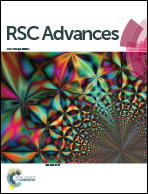Operando structural study of non-aqueous Li–air batteries using synchrotron-based X-ray diffraction†
Abstract
Non-aqueous lithium–air batteries (LABs) attract attention as a candidate technology for next-generation energy storage devices. It is crucial to understand how the discharge product Li2O2 is formed and decomposed by the electrochemical reactions to improve the cycle performance and decrease the charge voltage, which are the most important subjects for LAB development. Here, operando X-ray diffraction with high-brilliant X-rays in a transmission mode was used to observe the intensity and structural changes of crystalline Li2O2 in an operating non-aqueous LAB in real time, and the Li–O2 electrochemical reaction involving Li2O2 formation and decomposition was clearly demonstrated. The electrochemically formed Li2O2, which had an anisotropic domain size of 10 nm in the c-direction and 40–70 nm in the ab-plane, grew due to the increase of the number of domains during the discharge process. No other reaction products with a crystalline phase such as LiOH were found in either the cathode or anode of the LAB, whereas the accelerated decomposition rate of the domains was accompanied with the change of the domain shape and lattice constant of the c-axis in the latter half of the charge process with voltage higher than 4 V.



 Please wait while we load your content...
Please wait while we load your content...